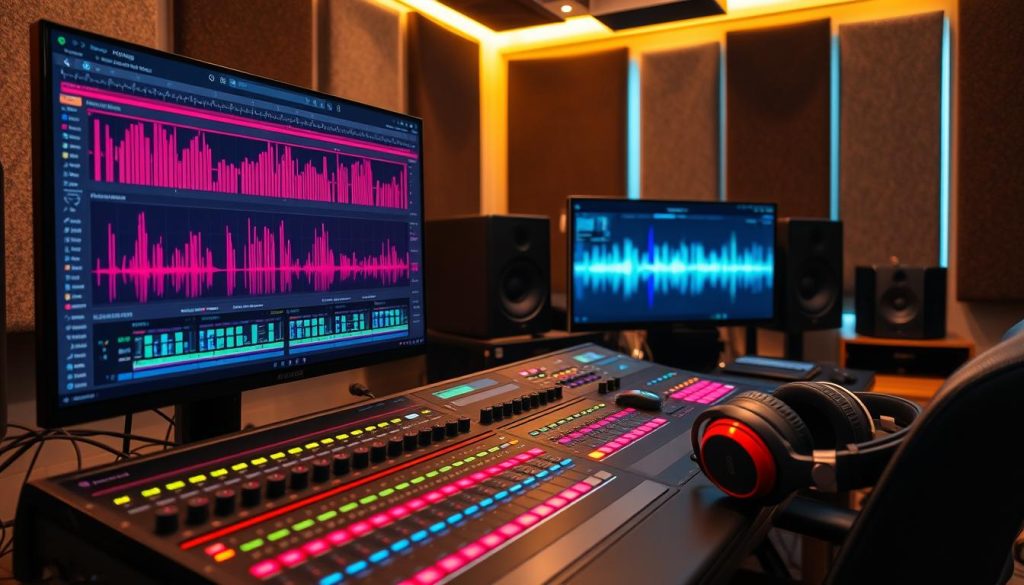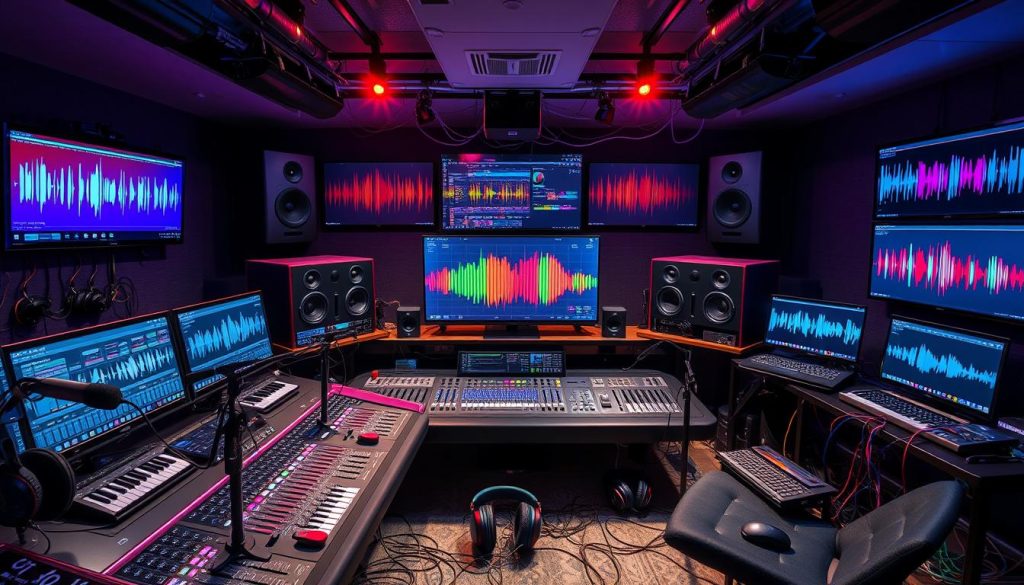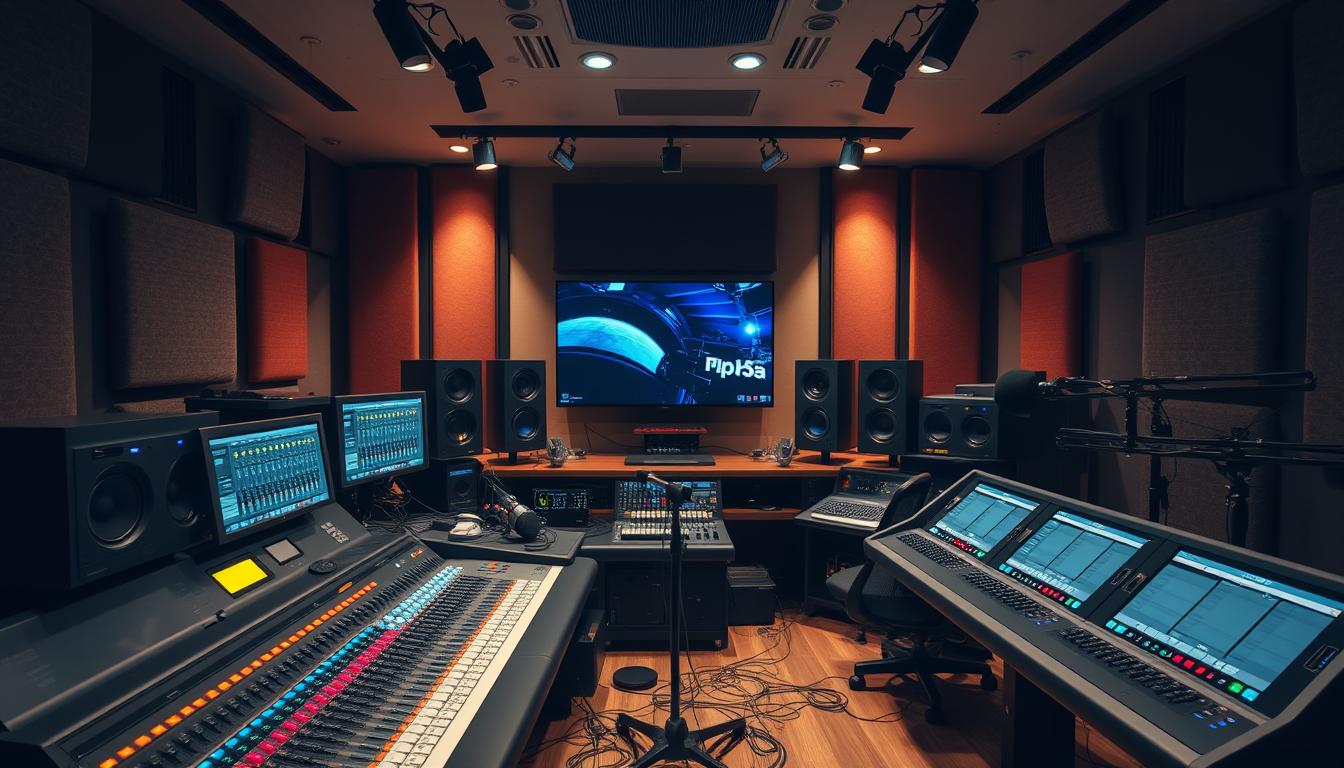I’ve spent my career making TV shows sound amazing. TV audio production is more than just recording sounds. It’s about making sure all the sounds work together perfectly.
In this article, we’ll explore TV audio production. We’ll look at important techniques and standards. You’ll learn about audio mixing, file formats, loudness standards, and more.
We’ll also talk about audio-video sync, routing, and mastering for TV. By the end, you’ll know a lot about TV audio production. You’ll be ready to make amazing audio for TV shows.
Importance of Audio Mixing in TV Production
Audio mixing is key to a great TV show. It blends dialogue, sound effects, and music. This makes the sound clear, immersive, and engaging.
Enhancing Dialogue Clarity
Clear dialogue is crucial for TV shows. Techniques like dynamic compression make sure every word is clear. This keeps viewers focused on the story without straining to hear.
Creating Atmosphere and Mood
Audio mixing does more than just make dialogue clear. It uses sound effects and music to take viewers to different places. This makes the story feel more real and emotional.
Working together, audio mixing and visual teams make TV shows better. They make sure the sound and pictures work together perfectly. Audio mixing is key in making TV sound great.
Channel and Audio Format Requirements
In TV audio production, following certain rules is key. These rules help make sure the audio works well with broadcasts. The SMPTE 320M-B standard sets the rules for stereo and 5.1 audio channels.
SMPTE 320M-B Channel Allocation
The SMPTE 320M-B standard says which channels to use:
- Left (L)
- Right (R)
- Center (C)
- Low-Frequency Effects (LFE)
- Left Surround (Ls)
- Right Surround (Rs)
This standard helps TV audio makers make sure their audio sounds great. It makes the sound come alive for viewers.
Accepted File-Based Formats and Codecs
Broadcasters also have rules for file formats and codecs. These rules help keep the quality of audio the same everywhere. The allowed formats are:
- PCM AES
- 24-bit, 48kHz
- 8 channels
Following these rules makes sure TV audio meets high standards. It also makes sure the audio works well with broadcasts. This gives viewers a great audio experience.
TV audio production: Loudness Standards
In the TV audio production world, keeping the right TV audio loudness is key. The ATSC A/85 Recommended Practice sets the standard for broadcast audio loudness. It makes sure the volume stays the same across all shows and platforms.
ATSC A/85 Recommended Practice
The ATSC A/85 standard says all TV audio must be at a loudness level of -24 LKFS. This level can vary by up to 2 dB. This rule keeps the TV audio levels steady. It stops sudden volume changes that can ruin the show.
Audio engineers must watch and tweak the volume during production. They follow the ATSC A/85 rules to give viewers a smooth audio experience. This way, the broadcast audio loudness stays right, making watching TV more fun and engaging.
Mastering Music for TV and Sync Licensing

Mastering music for TV and sync licensing is different from regular music mastering. It needs a special touch. TV music mastering breaks the audio into parts, making it easier to mix and match for different scenes.
Stem Mastering Techniques
Stem mastering gives music producers control over each sound. This is key for TV music, where the sound must match the pictures perfectly. It’s also great for making music for sync licensing, where you might need just the tune or the vocals.
By mastering music in stems, producers can make sure it fits TV and licensing needs. This way, they can adjust the music for different scenes or requests.
- Separate individual instrument and vocal groups into discrete audio stems
- Process each stem independently for optimal balance and integration
- Create multiple versions of the music, such as instrumental-only or vocals-only mixes
- Ensure that the final master is tailored to the technical requirements of TV and sync licensing
Stem mastering helps music producers make music that’s just right for TV and licensing. It makes the sound better and lets producers meet the needs of TV makers and licensing pros.
Audio-Video Synchronization (Lip Sync)
Keeping the audio and video in sync is key in TV audio production. The audio should be within 15ms ahead or 45ms behind the video. This ensures a smooth and believable experience for viewers.
As an audio engineer, I make sure the audio matches the action on screen. This makes the final product smooth and engaging for TV viewers. If the audio and video don’t sync up right, it can be annoying and hurt the show’s quality.
To keep the audio and video in sync, I use several methods and tools, including:
- Precise timing adjustments to the audio to align with the video
- Monitoring waveforms and visual cues to identify any discrepancies
- Leveraging specialized audio-video sync software and hardware
- Collaborating closely with the video team to ensure a cohesive final product
By getting good at audio-video sync, TV audio producers like me can make shows that pull viewers in. The details matter a lot in TV audio production and broadcast audio.
| Tolerance Range | Description |
|---|---|
| +15ms | Maximum allowable audio lead |
| -45ms | Maximum allowable audio delay |
Routing and Processing for Stem Mastering

In TV audio production, stem mastering is key for great results. It’s different from traditional stereo mastering. Stem mastering works on groups of instruments or vocals separately.
This method puts similar sounds together in one channel. It makes processing easier and more focused. It also lets audio engineers make many versions of the master for different uses.
Consolidating Stems for Efficient Processing
Consolidating stems changes the game in TV audio. Engineers can now work on specific parts like dialogue, music, and effects. This keeps the mix’s quality while making it easy to adjust for different needs.
| Stem Mastering Advantages | Traditional Mastering |
|---|---|
|
|
Stem mastering gives audio pros more power and control in TV audio. It makes the process more efficient and creative. This method improves audio quality and makes it easier to deliver custom versions for different uses.
Creating Master Versions for Sync Licensing
Mastering music for TV and sync licensing is more than just making one master version. Audio engineers must make many special mixes for TV. These mixes help producers and music supervisors use the music in different ways.
The typical set of master versions includes:
- Instrumental mix: A version of the track without any vocals or vocal processing, allowing the dialogue to take center stage.
- Vocals-only mix: A mix that isolates the vocal elements, enabling the music to be used as a background or underscore without competing with the spoken word.
- No percussion mix: A version that removes the rhythmic elements, making it easier to incorporate the music into scenes where the focus is on mood and atmosphere rather than a driving beat.
Audio engineers make these special master versions to meet the needs of the sync licensing industry. This makes their music more versatile and marketable for TV. It helps the music fit well with the visuals, whether it’s for dialogue, mood, or rhythm.
| Master Version | Purpose |
|---|---|
| Instrumental Mix | Allows the dialogue to take center stage without competition from vocals |
| Vocals-only Mix | Enables the music to be used as a background or underscore without interfering with the spoken word |
| No Percussion Mix | Facilitates the integration of the music into scenes focused on mood and atmosphere rather than rhythm |
By giving a full set of master versions, audio engineers make their music more versatile and marketable for TV. This smart approach makes sure the music fits well with the visuals. It meets the many needs of the sync licensing industry.
Mastering Audio for TV Programs and Films
As an audio engineer, I know how complex mastering audio for TV and films is. It’s not just about making sound better. It’s about making sure the sound and pictures work together perfectly. This makes the movie or show more engaging for everyone watching.
I’ve learned a lot about TV and film audio mastering. I make sure the sound fits the pictures well. This makes the movie or show a true work of art.
Improving dialogue, creating soundscapes, and keeping the volume right are key. I follow strict rules and standards to make sure the audio is ready for TV. This is true for all kinds of shows, from action movies to documentaries.
I do more than just master the audio. I also make sure the sound and pictures are perfectly in sync. This is called “lip sync.” It makes the movie or show more real and engaging.

